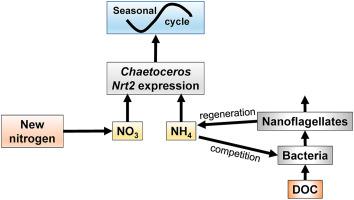Continental Shelf Research ( IF 2.3 ) Pub Date : 2021-07-17 , DOI: 10.1016/j.csr.2021.104506 Chi-Yu Shih , Wei-Cheng Liu , Ting-Hsuan Kuo , Ya-Fan Chan , Yun-Chi Lin , Gwo-Ching Gong , Lee-Kuo Kang , Jeng Chang

|
In this study, the mRNA levels of a diatom nitrate transporter gene, Nrt2, were investigated in a coastal ecosystem on the western boundary of the northwestern Pacific Ocean. During the period between June 2011 and June 2013, 14 cruises were conducted, and samples were collected for nutrient-manipulation incubations, quantitative polymerase chain reactions (qPCRs), and metatranscriptome construction. Based on metatranscriptomes generated through next-generation sequencing, the dominant diatoms and sequences associated with Nrt2 as well as EFL, a qPCR reference gene, were identified. Next, primer pairs for a dominant bloom-forming diatom, Chaetoceros cf. curvisetus, were designed, and the expression levels of Nrt2 were measured by qPCR in both original (untreated) and nitrogen-deprived samples. By calculating the ratio of Nrt2 expression between these 2 samples, a Log (fNrt2) index was developed to be used as a molecular indicator of nitrogen demand. At our study site, the nitrate and nitrite concentrations displayed a clear seasonal cycle, with high (8.75 μM) and low (0.05 μM) concentrations occurring in December and June, respectively. The Log (fNrt2) index also varied with time in 2012, with a high value of approximately −1.44 occurring in October or November; this variation was not in phase with the nitrate trend. The regression analysis indicated that Log (fNrt2) was inversely correlated with nitrate and nitrite concentrations. On the other hand, Log (fNrt2) was positively correlated with bacterial abundance. This regression equation properly included values of Log (fNrt2) that were not well explained by the nitrate and nitrite concentrations. When the Chaetoceros abundance increased, the associated low value of Log (fNrt2) suggested the repression of Nrt2 by ammonium; apparently, the diatom utilizes ammonium as the nitrogen source to maintain its dominance in the later phase of the bloom. Since bacteria and nanoflagellates are actively involved in the uptake and release of nitrogenous nutrients, these two functional groups also control the expression of Nrt2 through important ecological processes such as competition and regeneration.


























 京公网安备 11010802027423号
京公网安备 11010802027423号